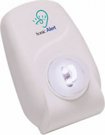Deaf people notice a baby crying by the baby's appearance, but technology cant alert them to the baby's cries when they are out of the room. Special baby monitors and pagers use vibration and lights to get deaf parents' attention, or specially trained dogs can provide this service. Today, deaf parents have several options to help them recognize when their baby is crying.
- History
- In the past, technology for deaf people was not readily available, and deaf individuals had trouble finding baby monitors that would allow them to recognize their babies' cries when they were out of the room. For instance, in 1986, friends of a deaf father wrote to the Miami News' philanthropist, Percy Ross, seeking aid. They had researched baby monitors for the deaf but had been unable to obtain one. Mr. Ross sent them a baby monitor and receiver in the mail. Today, baby monitors for the deaf are commonplace.
- Of course, deaf parents can recognize that their babies are crying by their babies' facial expressions. Deaf parents must tune in to babies' most subtle movements and expressions, especially if they are across the room where facial expressions are not as obvious.
- Deaf individuals usually rely on visual alarms to tell them when the phone is ringing, when someone is at the door, and as alarm clock alerts. The same is true of baby monitors. When leaving their baby in another room, deaf parents use baby monitors that are similar to other monitors, except that deaf people connect the monitor in their room to a lamp. When the monitor detects sound in the baby's room, the lamp flashes to alert the parents. Other monitors have their own flashing lights.
- Deaf people also use vibrating pagers to alert them of common alarms in their households, including with baby cry transmitters. Deaf parents place the transmitter near their baby when they leave the room, keeping the programmed pagers with them. When the baby cries, the transmitter sends a radio signal to the pager, which vibrates. These are convenient for deaf people who may be doing chores outside the house or are moving from room to room, as they can take the pagers with them and do not have to rely on a stationary lamp.
- Some deaf individuals adopt hearing dogs from organizations like Dogs for the Deaf. These dogs become part of the family and use their training to alert deaf people to sounds such as the oven timer, the tea kettle, the smoke alarm--or a baby's cries.
Facial Expression
Flashing Baby Monitors
Vibrating Pagers
Hearing Dogs


